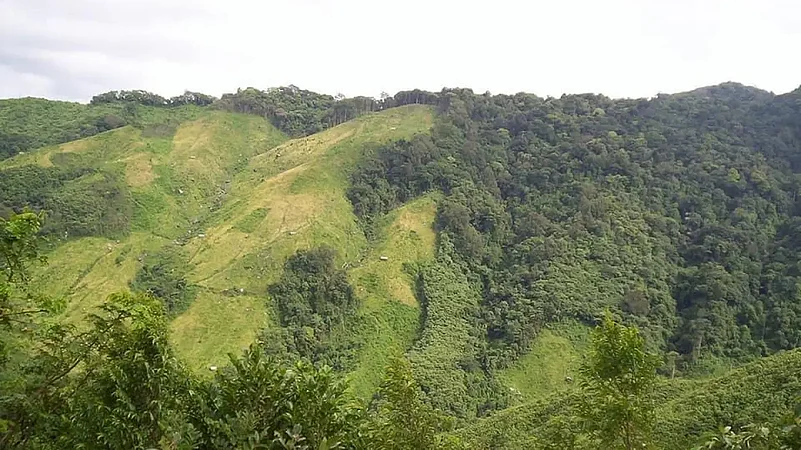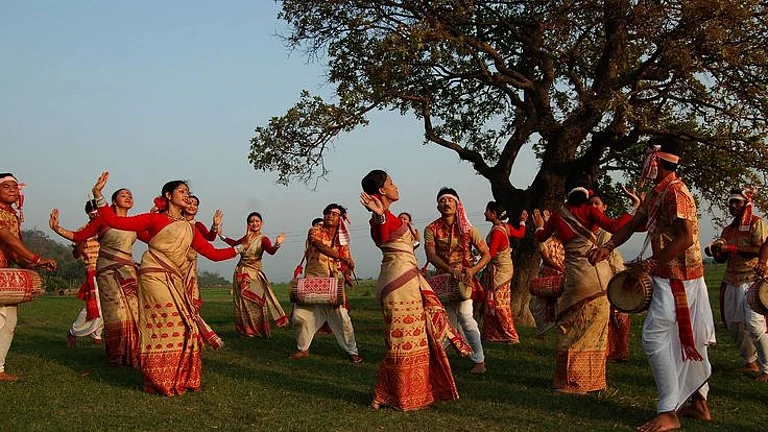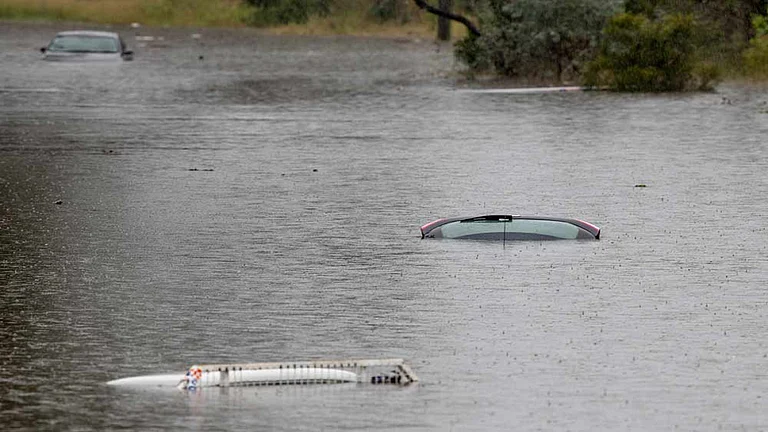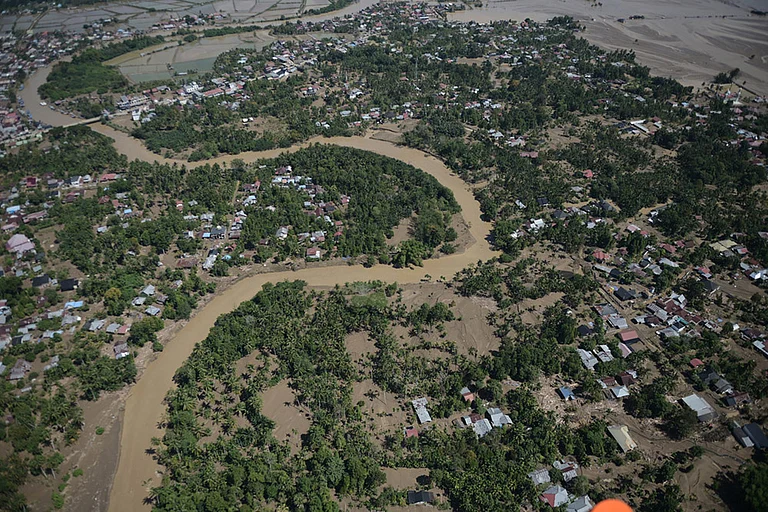Musharaf Khan, 41, is a school teacher in the Barpeta district, about 95 kilometres from Guwahati. Until a decade ago, he lived in Tarabari char (sand bar) along the Brahmaputra and cultivated jute, rice and vegetable. However, over the past ten years, Khan has been a climate refugee, shifting from one char to another, till the floods wash away his house.
Sitting along the mighty river, Khan sings:
Ghar Baari charlam re
Chira Khatar gaat ti loyare
Aaha Bidhi…
Kashi ta pesailam re…
Pater Kusta diya
……………………
Maati Baari Jaha chilo
Sab gelo bhahia re..
Amai Sarbanash Koriya
Haans, kukra Goru Chagal
Gelo Sab Bhasiya re
(I left my home and field
With a blanket and few memories
Oh fate of mine
All I have left with a sickle with remaining jute
…………….
My land, my farm all got wiped
And destroyed me as well
The hens, the chickens, the cows and the goat
All got swept away
All I have left with is a sickle
With remaining jutes...)
“Tarabari was a business hub with people from various ethnic diversities residing here. However, because of displacement induced by the flood, the once-prosperous town of Barpeta was reduced to a sand bar. Now Tarabari remains only in the imagination of the people,” he tells Outlook. A year ago, Khan built a house in the Borohi area of the district, away from the river.

In another corner of the state, 90-years-old folk singer Swarnalata Deori belongs to the “Deori” community, one of the river communities of Assam. Most of her songs talk about the Deori history of migration through the river Brahmaputra due to floods and erosion. She lives in Narayanpur, a small village situated in the Lakhimpur district of Assam, some 390 km from Guwahati. She has seen floods since her childhood and the changing nature of it.
“Floods were very scary previously. We made our stilt house a little higher to avoid floods during the monsoon. My songs mostly talk about losing my near and dear ones due to flood.”
Songs are the only medium through which she can preserve and educate her next generation about their past and history, culture and tradition.
India’s Northeast, a scenic hotspot of tribal communities and biodiversity, has been witnessing floods, dry spells, heavy downpours, cyclones and other weather extremes.
Meghalaya is well known for its practice of shifting cultivation, locally known as Jhum cultivation. Practised in the side tracks of the Khasi and Garo hills of Meghalaya, Jhum is not only a means of livelihood but is a part of the life, culture and traditions of the hill communities of Northeast India where agriculture is the primary occupation.
Of late, however, long dry spells and hot periods, late rainfall and reduction of soil moisture have been a major concern for crop production for these tribal communities. Consequently, farmers are shifting to professions like mining, driving and security guards.
A fear of food insecurity due to declining farming is found in a folk song of the Khasi community in the West Khasi Hills of the state.
Sohsatsnemshakhmat
Bun sakisahepsuda
Kansa poi kaporpisaka la pahuh
Haba u Nongrep u la duna,
ukhaw u la kyrduh
(Painful years ahead,
Farmers are decreasing
In this present advanced world with full of gentlemen
Time will come when money is plenty
Where farmers are less and food is extinct)
Arupjyoti Saikia, a Guwahati-based environmental historian, feels that one can get a glimpse of various communities' collective sense of local nature from a reading of the folk songs. Many of these tend to reflect communities' ways to negotiate with many lives of nature and its disruption.
“These folk songs also give a better idea of the meaning of climate for a community. Climate may be about water scarcity, warmer days or fewer fish in a local water body. Some folk songs might carry a sense of hope for better days or remedies for distress. Others can be ways to negotiate with many seasonal upheavals,” he says.
One such instance is a ritual called Bhekuli Biya which means Frog (Bhekuli) Wedding (Biya). This is a ritual primarily observed by the tea garden communities where a wedding takes place between two frogs to appease the rain gods during dry spells. One of the Frog's wedding songs (Bhekuli Biya Naam) goes:
Ujoni raajote bojai dhake-dhol
bojai devi-dolot doba
apunar raajoloi juagoi bhekuli
raaijok pani kori diya
(People from Upper part plays dhol
They play doba at Goddess’ abode
Oh frog go back to your own place
And bless the people with showers)
In Assam, annual floods wipe out villages after villages from its geographical map destroy paddy fields and houses along with the loss of human and animal lives. A folk song recorded by Chandrani Sinha, an independent journalist from Assam, expresses the anxiety of farmers on repaying loans to money landers due to floods damaging crops.
Ahe gelo Nadir Baan
Bohey Nilo khetir dhan
Hai rey boche kandisey kishan...
Mahajan ke ki dibo juban.
(The floods have come
And swept away the paddy
How do we make the money lander understand now
The farmers are sitting and weeping)
This song, sung by the tea tribe community in the Sivasagar district describes how the poor farmers have been affected by the flood from the Dikhow river in Eastern Assam, a tributary of the Brahmaputra.
Talking to Outlook, Sinha, who has been archiving folk songs among communities living alongside the rivers said, “The history, traditions and ecological knowledge of North-eastern communities are not well documented because of various factors including flood and natural disasters. However, through songs and folklore which are regarded as oral histories, you will find mention of climate change and its impact on livelihood issues.”
At present, Arunachal Pradesh is going through major deforestation due to the construction of over 150 dams in various rivers and also because of other developmental projects under Act East Policy. Deforestation has fastened the impacts of climate change in the form of rising temperature, and erosion of land among others. Nyishi is a major tribal community living alongside the Ranganadi river. In various folk songs of the community, mention of climate change adaption is found. In one such song, the community is expressing its willingness to try different crops and agricultural methods with the use of modern technology.
Modi Aniya Kaniya Taju
Ashi Aniya Nglu Kaniya Taju
Nglu ge sangcha so kataju Lungki Dadi
Aamge Aniya Geniya Taju
Mige Aniya Nglu Geniya Taju
Nglu ge sangcha so Aamge Aniya Geniya Taju
Nglu ge sangcha so Mige Aniya Nglu
(Now time has come to bring the new harvest
of different crops viz., paddy and others.
Let us learn about the useful technologies
and methods of cultivation from outsider too.)
In Mizoram, the land of highlanders, there is a folk song about a farmer requesting his devastated crops to rise up after a windstorm made them fall and wither. The folk song belongs to the Mara tribe, an indigenous tribe that dwells on the southern tip of Mizoram.
E….Ezeno y….kaw thau thala
Ehe hlochi vesi no y Rahne thli ma cha chape, cha chape...
Rahne thli ma cha chape
Che…kaw thau thala
Ehe hlochi vesi no y
Rahne thli ma cha chape, cha chape
Rahne thli ma cha chape
(Wake up and arise my clandestine paddy
How sad that thou have fallen.
Which tempest wind paid you a visit
To make you fall and wither
Wake up and rise again my beloved paddy
To deliver a healthy and an abundant harvest)

Saikia says, “For centuries or millennia, societies have adapted to local climate or nature in many ways, whether it is their everyday life, crops, culinary practices, housing requirements, or their understanding of plants or their relationship with the animal world.”
“These experiences are embodied into multiple forms of knowledge and cultural forms,” he says, emphasizing that “it is equally important to understand and explain these forms of knowledge in a sound and rigorous manner."
Perhaps that’s the key to a better understanding of climate and building a harmonious bond with it.


























